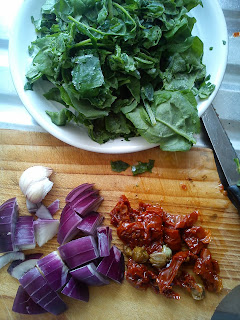 |
| Marrow & potatoes layer with beet and sweet corn stir |
Serves 3
 Ingredients for the layer:
Ingredients for the layer:
600grs Marrow
2 medium potatoes
3 medium firm tomatoes
100grs Tofu sliced and deep-fried to give it texture
1 small red onion (optional)
3 cloves of garlic
30grs butter (dairy free)
100ml Alpro single cream
50grs Flour
Vegetable stock cube
White pepper
Salt
Preparations:
1 - Peel the marrow and keep the skin strips for decoration. Now slice the peeled marrow in 1cm width and set aside. Peel the potatoes and cut in slices about the size as the marrow. set aside. Now do the same thing for the tomato and red onion. Make sure that your Tofu is deep-fried as it will give texture to your dish. Set aside.
2 –
for the batter: Melt about 25grs of the butter and crush the whole stock cube in it to melt it. Add the cream to the mix then add the flour and the finely chopped garlic. Mix well, add salt and white pepper. Set aside.
Preheat the oven at 180 degrees.
 |
| Layer ready for the oven |
Method:
Butter a regular size loaf tin, place 1 layer of potatoes, then marrow, then onion, then tomatoes, then tofu. Dust with a pinch of salt and white pepper. Then repeat the process. If you can, make sure that a layer of potato is at the top of the dish simply because you will use it as indicator to judge if the dish it cooked.
The dark green strips you see on this photo are strips of peels from the marrow that I am using to decorate my dish. The strips were placed on the bottom of the baking tin, then folded over the dish and held with tooth pick just before placing it in the oven.
Once the layers are done. Stir the batter previously prepared and pour it,
not on top, but on the sides of the layers.
Now place your dish in the oven for 1hr 20 minutes.
Now time to prepare the accompaniment.
 Beet & corn stir
Beet & corn stir
For this, you will need:
1 big fresh sweet corn
1 precooked beetroot or a fresh one if you can find it
1 yellow sweet pepper
1 very small red onion
50grs roughly crush walnut
2 twigs of thyme
Fresh parsley
25grs Butter (dairy free)
Black pepper & salt obviously
Start by shelling the corn kernels from the cob or simply go through the cob with the knife like I did.
Chop separately all the elements of your dish then set aside.
 Now, in a frying pan, melt the butter and fry the chopped onions and thyme until brown. Now, add the sweet corn and stir for 2 minutes. Then add the sweet pepper in the mix, stir for 2 minutes, add the beetroot and the fresh parsley, stir well for 1 minute and add the crushed walnut. Season with salt and pepper, Mix, cover and remove from the stove. It is ready.
Now, in a frying pan, melt the butter and fry the chopped onions and thyme until brown. Now, add the sweet corn and stir for 2 minutes. Then add the sweet pepper in the mix, stir for 2 minutes, add the beetroot and the fresh parsley, stir well for 1 minute and add the crushed walnut. Season with salt and pepper, Mix, cover and remove from the stove. It is ready.
Time to check on your layers in the oven. The hardest ingredient in the dish is the potato. If you put a knife through the dish and it goes through smoothly, and comes up just slightly moist, then your dish is ready. if not, add cooking time to your oven.
Please note: not all oven perform with the same power
Leave your dish to cool for few minutes then, serve.
 |
| Serving suggestion |
Don’t forget to post a comment!
Bon appétit.
Nash













































